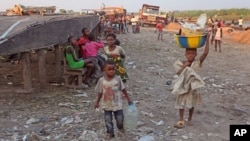GENEVA —
A new report by the World Food Program finds millions of people in the Democratic Republic of Congo are going hungry, and malnutrition rates are climbing due to a decline in foreign aid and ongoing conflict.
On paper, the DRC appears to be doing well. Since 2002, the country’s economy has grown on average six percent a year. This year, economic growth is expected to top nine percent.
Unfortunately, U.N. aid agencies say that little of that prosperity is trickling down to the population. The World Food Program says the government’s failure to invest in areas such as education, health care, sanitation, infrastructure and agriculture is undermining the country’s ability to feed itself.
Acute food shortage
WFP spokeswoman Elizabeth Byrs said this low level of government spending, combined with a decline in foreign aid and protracted conflict in the east is creating an alarming situation for the nearly 10 percent of the population facing an acute shortage of food.
“The families have poor diet… They have a high vulnerability to diseases and also to natural disasters because they are poor, because they have no balanced diet," said Byrs. "They do not eat properly and so their body is more vulnerable to diseases. Of course because of diseases, because of people who are not properly fed, it causes major disruption to crops, of course livestock, and altogether infrastructure.”
WFP reports that a staggering 95 percent of the people in the DRC earn less than $2 a day. It says nine percent of children under age five are acutely malnourished, and 43 percent suffer from chronic malnutrition, which is a critical state.
Myriad issues
The report finds rural areas suffer most from poverty, lack of food and high prevalence of malnutrition. It says internally displaced people and refugees from the Central African Republic are particularly vulnerable to food shortages -- as are local communities that host them.
WFP spokeswoman Byrs warned that her agency is very low on funding. She said it needs $21 million to carry out its humanitarian operations through October. Byrs warned that WFP will be forced to cut aid if it does not receive the money.
“We targeted two million people in 2014. Unfortunately, we will assist only 1.6 million if we do not get adequate funding from donors," she said. "We will target life-saving activities in acutely food insecure, and in particular children. There are two million children suffering from malnutrition, and we will focus on the life-saving program of WFP to ensure that those children get life-saving assistance.”
Because of the funding crisis, WFP is planning to reduce the geographical coverage of its work. Byrs said assistance programs will be largely cut in areas of no conflict. She said assistance programs will be maintained in the war zones, and where IDPs and refugees continue to reside.
On paper, the DRC appears to be doing well. Since 2002, the country’s economy has grown on average six percent a year. This year, economic growth is expected to top nine percent.
Unfortunately, U.N. aid agencies say that little of that prosperity is trickling down to the population. The World Food Program says the government’s failure to invest in areas such as education, health care, sanitation, infrastructure and agriculture is undermining the country’s ability to feed itself.
Acute food shortage
WFP spokeswoman Elizabeth Byrs said this low level of government spending, combined with a decline in foreign aid and protracted conflict in the east is creating an alarming situation for the nearly 10 percent of the population facing an acute shortage of food.
“The families have poor diet… They have a high vulnerability to diseases and also to natural disasters because they are poor, because they have no balanced diet," said Byrs. "They do not eat properly and so their body is more vulnerable to diseases. Of course because of diseases, because of people who are not properly fed, it causes major disruption to crops, of course livestock, and altogether infrastructure.”
WFP reports that a staggering 95 percent of the people in the DRC earn less than $2 a day. It says nine percent of children under age five are acutely malnourished, and 43 percent suffer from chronic malnutrition, which is a critical state.
Myriad issues
The report finds rural areas suffer most from poverty, lack of food and high prevalence of malnutrition. It says internally displaced people and refugees from the Central African Republic are particularly vulnerable to food shortages -- as are local communities that host them.
WFP spokeswoman Byrs warned that her agency is very low on funding. She said it needs $21 million to carry out its humanitarian operations through October. Byrs warned that WFP will be forced to cut aid if it does not receive the money.
“We targeted two million people in 2014. Unfortunately, we will assist only 1.6 million if we do not get adequate funding from donors," she said. "We will target life-saving activities in acutely food insecure, and in particular children. There are two million children suffering from malnutrition, and we will focus on the life-saving program of WFP to ensure that those children get life-saving assistance.”
Because of the funding crisis, WFP is planning to reduce the geographical coverage of its work. Byrs said assistance programs will be largely cut in areas of no conflict. She said assistance programs will be maintained in the war zones, and where IDPs and refugees continue to reside.







